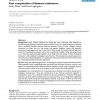Free Online Productivity Tools
i2Speak
i2Symbol
i2OCR
iTex2Img
iWeb2Print
iWeb2Shot
i2Type
iPdf2Split
iPdf2Merge
i2Bopomofo
i2Arabic
i2Style
i2Image
i2PDF
iLatex2Rtf
Sci2ools
BMCBI
2007
2007
Fast computation of distance estimators
Background: Some distance methods are among the most commonly used methods for reconstructing phylogenetic trees from sequence data. The input to a distance method is a distance matrix, containing estimated pairwise distances between all pairs of taxa. Distance methods themselves are often fast, e.g., the famous and popular Neighbor Joining (NJ) algorithm reconstructs a phylogeny of n taxa in time O(n3). Unfortunately, the fastest practical algorithms known for Computing the distance matrix, from n sequences of length l, takes time proportional to l·n2. Since the sequence length typically is much larger than the number of taxa, the distance estimation is the bottleneck in phylogeny reconstruction. This bottleneck is especially apparent in reconstruction of large phylogenies or in applications where many trees have to be reconstructed, e.g., bootstrapping and genome wide applications. Results: We give an advanced algorithm for Computing the number of mutational events between DNA sequ...
| Added | 09 Dec 2010 |
| Updated | 09 Dec 2010 |
| Type | Journal |
| Year | 2007 |
| Where | BMCBI |
| Authors | Isaac Elias, Jens Lagergren |
Comments (0)

